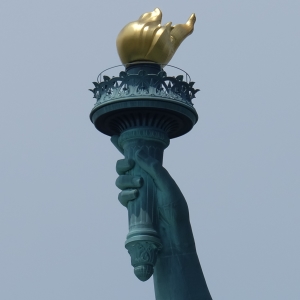Art in Action: Land of the Liberty Statue, Saved by Pulitzer

The beautiful golden torch that graced the statue once it was placed on the pedestal.
By DARLA MCCAMMON
Lakeland Art Association
The 12 acre parcel called Bedloe’s Island that was later changed to the name Ellis Island had been selected for the site of the Statue of Liberty, but the progress on the base, or pedestal that would support the colossal work was slowed during the time of the depression. The President and Congress had made a commitment that Americans would provide the funds and support for this portion of the project, but many Americans had mixed feelings about this unusual and very large “gift.”
Congress did vote to accept the gift in a unanimous vote, but they neglected to provide any funding and it was the same with the City of New York as well as New York State. Times were tight.
Work on the statue itself was finished in 1884. It had been erected just outside Bartholdi’s studio in Paris. But the planned dismantling and shipping to the U.S. was stopped when it was realized the pedestal in New York wasn’t finished. More than $100,000 was still needed to complete it.
At this time some other cities began to vie to have the statue built in their location, and promised to provide the funds. Boston, San Francisco, Cleveland and Philadelphia jumped on this bandwagon. Joseph Pulitzer, who had been promoting the statue for New York and Ellis Island, became incensed at what he saw as insensitivity toward the French donation as well as parsimony on the part of citizens of this country. His newspaper now carried a great deal of prestige and influence, so Pulitzer began to hammer home the need for all donations, small and large. One of his famous quotes read, “The statue is not a gift from the millionaires of France to the millionaires of America, but a gift of the whole people of France to the whole people of America.” When he announced the ship carrying the crates with all the parts of the statue would leave France on a warship May 8, more interest and excitement was generated and funds finally began to pour in. They soon had enough to restart work on the project. A business famous for its’ Castoria Laxative offered $25,000 to help– provided the word “Castoria” could be displayed across the pedestal for one year. The thought of Lady Liberty needing a laxative was a bit much for those in charge. The generous offer was flushed!
Pulitzer not only captured the imagination of donors but increased the circulation of his World newspaper explosively. The ship came into New York Harbor and almost simultaneously the goal of One Hundred Thousand Dollars (at an average of 83 cents per donor) was reached. Euphotia erupted. Now the statue could have a home. It took another two years of work and assembling before President Grover Cleveland inaugurated the beautiful piece of work in a ceremony on October 28, 1886.
Next week: The closing chapter includes “the tired, the poor.”
Coming Up:
- Marilyn Kruger art exhibit: Warsaw City Hall Gallery 8 a.m. to 5 p.m. Monday through Friday.
- Oct. 4-29 Steve Creighton Kokomo Art Center 525 W. Ricketts St., Kokomo.
- Oct. 5, Robert Hudson and Jennifer Caudill-Penaherra exhibit 302 E. Winona Avenue.
For more information contact artist/author, Darla McCammon at [email protected] or website.
